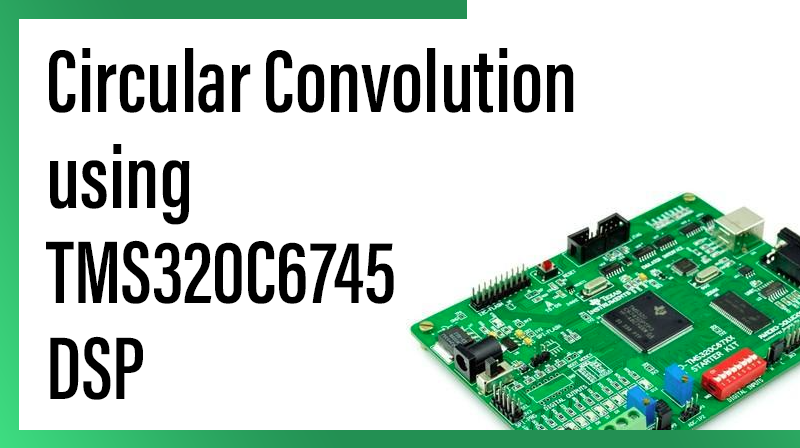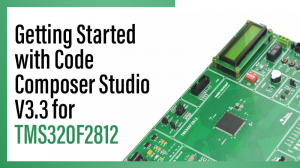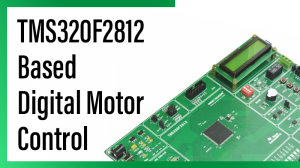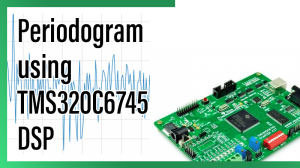
Circular Convolution using TMS320C6745 DSP
Aim
To perform the Circular Convolution of two given discrete sequence in TMS320C6745 KIT.
Requirements
☞CCS v4
☞USB Cable
☞5V Adapter
Theory
The circular convolution, also known as cyclic convolution. A convolution operation that contains a circular shift is called circular convolution. Circular convolution of two sequences x1[n] and x2[n] is given by
x1[n]*x2[n] = εk x1[k] x2((n-k))N, 0≤ n ≤N-1
where k ranges between 0 and N-1
One of the methods to find circular convolution….
In circular convolution the length of the output sequence will be equal to length of the input sequence ie. length(y)=length(x)
So first perform linear convolution using any of the methods u find easier.
If m is the length of ‘x’ and n is the length of the ‘h’ then length of ‘yl’ from linear conv is m+n-1.
Since length of output from circular conv is m, we will bring the last n-1 terms from ‘yl’ and add them to first n-1 terms. So the obtained output is circularly convoluted output.
For eg. if x= 1, 2, 3, 4 and h= 2,3,1 lin conv op ie. yl= 2,7,13,19,15,4
bring last two (n-1) terms to first two terms
so circularly convluted op is yc= 17, 11,13,19
Procedure for build a project on Circular Convolution using TMS320C6745 DSP
1. Open Code Composer Studio v4 .
2. In WorkSpace Launcher.
☞BROWSE → Select the project location and make one new folder, MAKE NEW FOLDER → Type the Workspace name, OK → OK.
3. FILE ⇒ NEW ⇒ CCS PROJECT
☞Project name: Type your project name.
☞Tick use default location. → NEXT
☞Project type C6000.
☞Tick Debug And Release. → NEXT → NEXT.
☞Output type: Executable.
☞Device Variant : generic – TMS320C6745.
☞Device Endianness : little
☞Code Generation Tools: TI v6.1.12.
☞Run time support library: automatic.
☞Target content: none. →FINISH
4.FILE ⇒ NEW ⇒ SOURCE FILE
☞Source file: Type your projectname.c( .c extension is must ).
☞Type the program.
☞FILE → SAVE.
5. Paste the following board library files in workspace location.
☞Common folder (contains header files)
☞Gel folder (contains gel file)
☞Library folder(contains library files)
6. Paste the Linker file in the project location.(linker file is available in cd)
Note: Those folders and linker file are availble at cd.
7. PROJECT ⇒ PROPERTIES ⇒ C/C++ BUILD → BASIC OPTION
☞Target processor version(–silicon version, -mv) : 6400+ OK.
☞IN C/C++ BUILD, → INCLUDE OPTIONS (Add dir to #include search path(–include_path,-I)) select this add icon and add the following three path by indivdually – “${Diag}../../common/header” – “${XDAIS_CG_ROOT}/packages/ti/xdais” – “${C6000_CSL_CG_ROOT}/include”
8. FILE ⇒ NEW ⇒ TARGET CONFIGURATION FILE
☞file name: projectname. ccxml (.ccxml extension is must)
☞Connection: Texas Instrument XDS100 v1 USB Emulator.
☞Device: TMS320C6745. (Tick the TMS320C6745)→ SAVE → TARTGET CONFIGURATION → C674X_0 → BROWSE, browse the workspace location, open the gel folder and select the GEL file. → OPEN → SAVE.
9. In C/C++ Project window, Right click the project ⇒ REBUILD PROJECT.
10. Connections
☞Connect the usb cable, PC to TMS320C6745 KIT.
☞Connect the 5v adapter.
☞Power on the kit.
11. TARGET ⇒ DEBUG ACTIVE PROJECT.
12. VIEW ⇒ MEMORY
13. In right side, memory window will open. Type the address and give the input at particular location.
Give the input as follow:
X(n) h(n) 0xC0001000 – 00000001 0xC0001030 – 00000001 0xC0001004 – 00000001 0xC0001034 – 00000001 0xC0001008 – 00000001 0xC0001038 – 00000001 0xC000100C – 00000001 0xC000103C – 00000001
14. TARGET ⇒ RUN.
15. TARGET ⇒ HALT.
See the Output at Particular location:
0xC0001050 – 00000004 0xC0001054 – 00000004 0xC0001058 - 00000004 0xC000105C - 00000004
Program for Circular Convolution using TMS320C6745 DSP
#include
int rot(int *x);
void main()
{
int *in1,*in2,*out,*temp,i,sum=0,j;
in1 = (int *)0xc0001000;
in2 = (int *)0xc0001030;
out = (int *)0xc0001050;
temp = (int *)0xc0002000;
for(i=0;i<4;i++)
{
if(i == 1)
temp[i+2] = in1[i];
else if(i == 3)
temp[i-2] = in1[i];
else
temp[i] = in1[i];
}
for(i=0;i<4;i++)
{
sum = 0;
for(j=0;j<4;j++)
{
sum+=(in2[j] * temp[j]);
}
out[i] = sum;
rot(temp);
}
while(1);
}
rot(int *x)
{
int t;
t = x[0];
x[0] = x[3];
x[3] = x[2];
x[2] = x[1];
x[1] = t;
}
Result
Thus, the Circular Convolution of two given discrete sequence has performed and the result is stored at memory location (0xC0001050).



